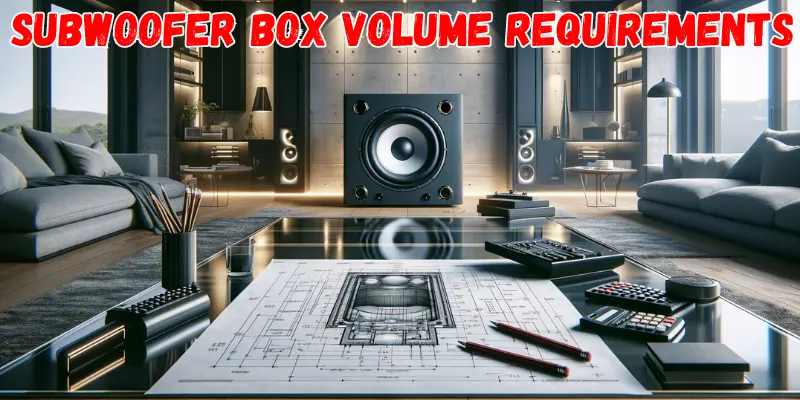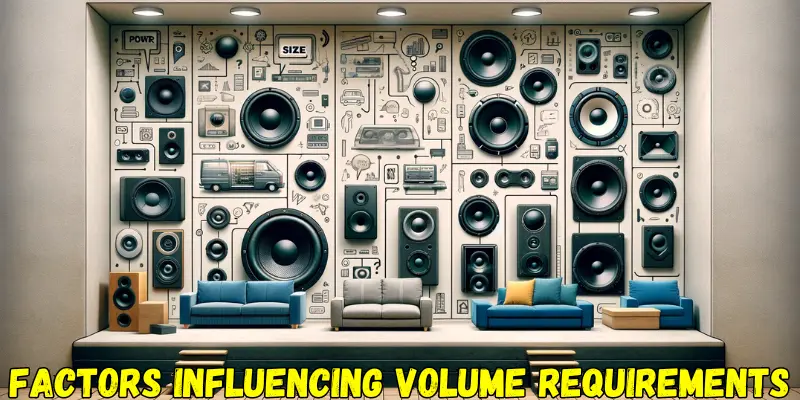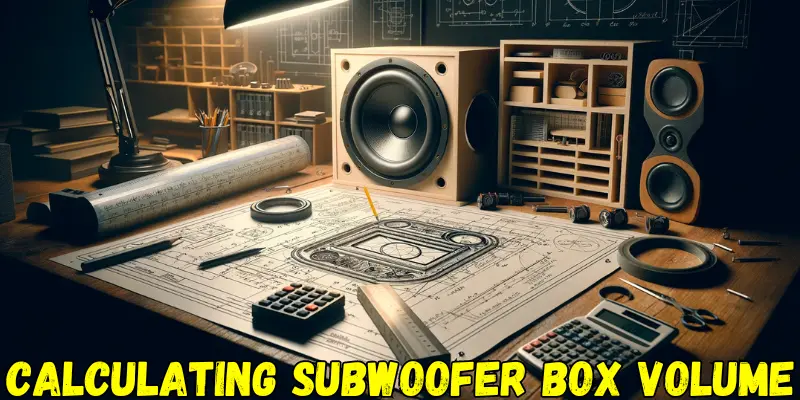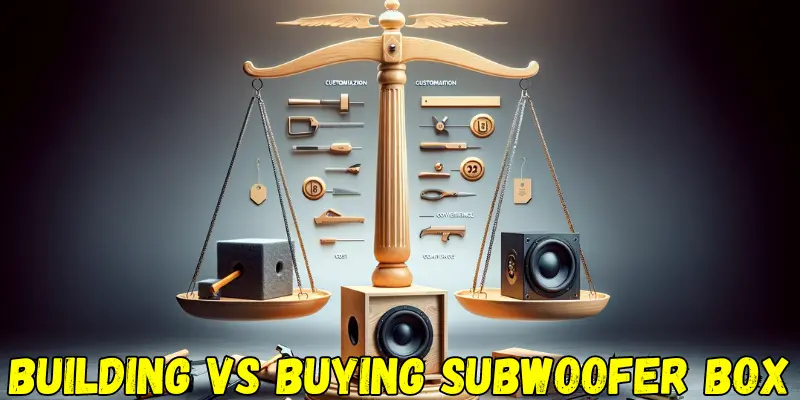
Understanding the Subwoofer Box Volume Requirements is crucial for anyone wanting to enhance their audio experience. We’re diving into how the volume of a subwoofer box not only affects sound quality but can also transform your listening experience.
Whether you’re a seasoned audiophile or new to the world of audio, this article aims to guide you through the essential steps of determining and calculating the perfect volume for your subwoofer box.
From exploring different subwoofer box types to providing easy-to-follow calculations and practical tips, we’re here to help you make informed decisions for your audio setup. So, let’s get started on this path together, ensuring your audio system hits the right notes every time.
- Understanding Subwoofer Box Volume Requirements
- Factors Influencing Subwoofer Box Volume Requirements
- Calculating the Ideal Subwoofer Box Volume
- Tools and Resources for Subwoofer Box Design
- Building vs. Buying a Subwoofer Box: What to Consider
- Subwoofer Box Volume Requirements Common Mistakes to Avoid
- Conclusion on Subwoofer Box Volume Requirements
- FAQs: Subwoofer Box Volume Requirements
Understanding Subwoofer Box Volume Requirements

When we talk about subwoofer box volume, we’re really getting into the heart of what makes your audio setup tick. Think of the subwoofer box as the home where your subwoofer lives.
Just like us, if it’s too cramped or too spacious, it’s not going to perform at its best. The volume of this box plays a pivotal role in sound quality, affecting everything from the bass depth to how clear each beat sounds.
Why Volume Matters
The volume of your subwoofer box is essentially the amount of space inside it, measured in cubic feet or liters. This space dictates how much air your subwoofer can move.
Too little space, and your bass might sound tight or restricted. Too much space, and it may lose its punchiness, sounding more diffuse than impactful. Getting this balance right means your subwoofer can produce deep, rich bass that truly enhances your music or movies.
Types of Subwoofer Boxes and Their Volume Needs
There are mainly three types of subwoofer boxes: sealed, ported, and bandpass. Each type has a unique way of handling sound, which affects their volume requirements.
Sealed Boxes:
These are the simplest, providing a tight and accurate bass response. They’re completely closed off, which means they need less volume to operate effectively.
If you love clear, precise bass notes, a sealed box might be your go-to. But remember, because of their design, they might require more power to reach the same volume as other types.
Ported Boxes:
These have a vent (or port) that allows air to move in and out. This design boosts the subwoofer’s efficiency, allowing it to produce louder, more vibrant bass at lower frequencies. Ported boxes generally require more volume than sealed boxes because the air movement inside the box contributes to the sound.
Bandpass Boxes:
A bit more complex, these boxes are essentially a combination of sealed and ported designs, with the subwoofer enclosed in a dual-chambered box. One chamber is sealed, while the other is ported, aiming to combine the benefits of both types.
Bandpass boxes can be quite specific in their volume requirements to achieve the desired sound effect, often aiming for very powerful bass at a narrow frequency range.
Understanding the volume requirements of your subwoofer box is crucial for achieving the best sound quality. Whether you choose a sealed, ported, or bandpass box, ensuring the volume matches your subwoofer’s needs will help you enjoy your audio experience to the fullest. We’re here to guide you through these decisions, making sure you get the most out of your audio setup.
Elevate your car’s audio to the next level with our step-by-step guide on How to Build a Car Subwoofer Box. We show you how to craft the perfect box, ensuring your drives are always accompanied by crisp, powerful bass.
Factors Influencing Subwoofer Box Volume Requirements

When setting up your subwoofer, it’s not just about picking a box and hoping for the best. Several factors can significantly influence the volume requirements of your subwoofer box, ensuring that you get the perfect match for your needs. Let’s dive into some of these critical factors, keeping things simple and straightforward.
Subwoofer Size and Power Handling
The size of your subwoofer is a big deal. Generally, larger subwoofers need larger boxes. It’s like giving them a bigger playground to work with, allowing for deeper and more powerful bass. But, it’s not just about size; power handling plays a crucial role too.
A subwoofer with higher power handling might need a bigger box to manage the extra energy and provide optimal performance. We’re looking for that sweet spot where your subwoofer has enough room to deliver its best without going overboard.
The Space You’re Filling: Vehicle or Room Size
Where you plan to use your subwoofer matters a lot. In a compact car, space is at a premium, and you’ll need a box that fits snugly while still delivering great sound.
In contrast, a larger room or space might benefit from a bigger subwoofer box that can fill the area with sound. It’s all about matching the box volume to your space to ensure the bass isn’t lost or overwhelming.
Subwoofer Specifications: The Manufacturer’s Guide
Manufacturers know their products best. They provide specifications for a reason, including recommended box volumes for optimal performance. These specs are like a cheat sheet to getting the best out of your subwoofer.
Ignoring them can lead to subpar performance or even damage to your subwoofer. Whether it’s the recommended sealed or ported box volume, taking note of these specifications can save you a lot of guesswork and ensure your setup is on point.
Choosing the right volume for your subwoofer box isn’t just about following a formula. It’s about considering the size and power of your subwoofer, the space you’re working with, and the guidance provided by the manufacturer.
By paying attention to these factors, you’re setting yourself up for an audio experience that’s not just heard but felt. We’re here to help you make these decisions, ensuring your bass sounds just right, whether you’re in your car or relaxing at home.
Ever wondered Do Subwoofers Need a Box to deliver that punchy bass? Dive into our article where we break down the essentials, helping you understand the magic behind the music in your space.
Calculating the Ideal Subwoofer Box Volume

Finding the perfect volume for your subwoofer box can feel like a puzzle. But don’t worry, we’re here to break it down for you, step by step.
Whether you’re crafting a box for a sealed, ported, or bandpass setup, understanding the basics will help you achieve that deep, resonant bass you’re after.
Let’s dive into how you can calculate the ideal volume for your subwoofer box, complete with formulas and examples to make it crystal clear.
Step 1: Choose Your Subwoofer Box Type
First things first, decide whether you’re going for a sealed, ported, or bandpass box. Each type has its own formula for calculating volume, so knowing your direction is crucial.
Step 2: Gather Your Subwoofer’s Parameters
You’ll need specific parameters from your subwoofer, typically found in the manufacturer’s specs. Key figures include the Fs (resonance frequency), Qts (total Q of the speaker), and Vas (equivalent compliance volume). These will feed into your calculations.
Step 3: Calculating Volume for Different Box Types
Sealed Boxes:
The formula for a sealed box is relatively straightforward. A good starting point is using the manufacturer’s recommended volume. If that’s not available, a general formula is: Vb=Vas/(Qts2.87) This gives you the volume in cubic feet. For example, if your subwoofer’s Vas is 2.4 cubic feet and its Qts is 0.7, your box volume (Vb) would be around 0.5 cubic feet.
Ported Boxes:
Ported boxes require a bit more calculation. You’ll calculate the volume using the formula: Vb=Vas/15×(Qts2) , you’ll need to calculate the port size based on the box volume and desired tuning frequency, but let’s keep it simple here.
Bandpass Boxes:
Bandpass calculations can get complex, as they depend on the specifics of the sealed and ported sections. It’s often best to follow specific design software or manufacturer recommendations for these.
Tips for Adjusting Calculations
Calculating the ideal subwoofer box volume doesn’t have to be daunting. By following these steps and understanding the basic formulas, you’re well on your way to crafting a subwoofer box that brings out the best in your bass.
Remember, these calculations are a starting point. Adjustments based on your specific needs and preferences are not just okay; they’re encouraged.
Tools and Resources for Subwoofer Box Design

Designing the perfect subwoofer box doesn’t have to be a solo journey. Thanks to a plethora of tools and resources available online, you can tap into expert knowledge and precision engineering right from your computer or smartphone.
Whether you’re a DIY enthusiast or a seasoned audio professional, these tools can simplify the design process, ensuring your subwoofer box meets the exact specifications for optimal sound quality.
Let’s explore some of the top software and online calculators, as well as handy apps for smartphone users, that can assist you in this endeavor.
Online Calculators and Software
WinISD:
This is a go-to for many audio enthusiasts. WinISD is a free and comprehensive speaker design software that allows you to calculate the dimensions and tuning of your subwoofer box.
Whether you’re planning a sealed, ported, or bandpass enclosure, WinISD provides detailed graphs and parameters to fine-tune your design for the best performance.
Sub Box Calculator:
An easy-to-use online tool that offers quick calculations for sealed and ported subwoofer boxes. Just enter your subwoofer’s parameters (like Vas, Fs, and Qts) and the desired box type, and it will give you the ideal dimensions for your subwoofer box.
Apps for Smartphone Users
Speaker Box Lite:
Available for both Android and iOS, this app is a fantastic tool for on-the-go calculations. It simplifies the process of designing your subwoofer box by providing instant recommendations for box volume and port dimensions based on your subwoofer’s specifications.
Subwoofer 101:
Perfect for beginners, this app guides you through the basics of subwoofer box design, offering tips and tricks to get the best sound from your setup. It’s user-friendly and a great starting point for those new to the audio world.
Why These Tools Matter?
Using these tools can significantly enhance the accuracy of your subwoofer box design. They help eliminate the guesswork, ensuring your box is perfectly tailored to your subwoofer’s needs and your personal preferences. Plus, they can save you time and resources by getting it right the first time, avoiding costly mistakes or unsatisfactory sound quality.
Building vs. Buying a Subwoofer Box: What to Consider

When it comes to enhancing your audio experience, choosing between building your own subwoofer box or buying a pre-made one is a significant decision. Both options have their unique advantages and challenges.
Let’s break down what you need to consider, focusing on the pros and cons of each choice and how subwoofer box volume requirements play into your decision-making process.
Building Your Own Subwoofer Box
Pros of Building Your Own Subwoofer Box:
Cons of Building Your Own Subwoofer Box:
Discover the secrets of creating the perfect sound experience with our latest guide on how to build a Subwoofer Box. We’ll walk you through every step, ensuring you get the best bass performance in your own setup.
Buying a Pre-Made Subwoofer Box
Pros of Buying a Pre-Made Subwoofer Box:
Cons of Buying a Pre-Made Subwoofer Box:
How Volume Requirements Influence the Decision?
The volume requirements of your subwoofer are crucial in this decision. If your subwoofer needs a very specific volume to perform optimally, building your own box might be the way to go. This ensures you can design the box to meet these requirements precisely.
On the other hand, many pre-made boxes come in standard sizes and volumes, which might be perfectly suited for your subwoofer, offering a convenient and quick solution.
Choosing between building or buying a subwoofer box depends on your priorities, skills, and the specific needs of your subwoofer. If you value customization and have the time and skills, building your own box can be a rewarding project.
However, if convenience and professionalism are your top priorities, a pre-made box might be the best choice. Remember, the goal is to enhance your audio experience, so consider what approach will best meet your needs and lead to the most satisfying sound.
Subwoofer Box Volume Requirements Common Mistakes to Avoid
When diving into the world of subwoofer boxes, it’s easy to get caught up in the excitement and overlook some critical aspects. However, paying attention to the details, especially volume requirements, can make a huge difference in your audio experience. Let’s talk about some common pitfalls and how you can steer clear of them for the best sound quality.
Unlock the full potential of your bass with our easy guide on How to Tune a Subwoofer Box. We’ve broken down the process into simple steps, so you can achieve deep, rich bass tones that truly transform your audio experience.
Ignoring Volume Requirements
Mistake:
One of the most frequent errors is overlooking the subwoofer’s volume requirements. Each subwoofer needs a specific amount of space to perform optimally. Too little or too much space can significantly impact sound quality.
Advice:
Always check the manufacturer’s specifications for volume requirements. If you’re building your own box, use a reliable calculator or software to determine the ideal volume based on these specs.
Not Considering the Type of Box
Mistake:
Another mistake is not matching the box type to your subwoofer and listening preferences. Sealed, ported, and bandpass boxes each offer different sound qualities.
Advice:
Understand the differences between box types and how they align with your subwoofer’s characteristics and your desired audio output. If you’re unsure, a sealed box is a safe bet for tight, accurate bass, while ported and bandpass options can provide more volume and depth.
Overlooking the Importance of Material and Build Quality
Mistake:
Underestimating the impact of material and build quality on the sound. The durability and acoustic properties of the materials used can significantly affect performance.
Advice:
Invest in high-quality materials and ensure the box is built solidly. MDF (Medium Density Fiberboard) is a popular choice due to its density and acoustic properties. A well-constructed box will not only sound better but also last longer.
Skipping the Fine Tuning
Mistake:
Failing to fine-tune the box after installation. Even with perfect calculations and construction, the real-world environment can affect sound performance.
Advice:
After installing your subwoofer box, take the time to fine-tune the system. Adjustments to the positioning, crossover settings, and equalization can enhance sound quality. Listening tests in various conditions will help you dial in the perfect settings.
Forgetting About Ventilation
Mistake:
In ported and bandpass designs, incorrect port size or lack of proper ventilation can lead to suboptimal performance or even damage to the subwoofer.
Advice:
Ensure your design includes correctly sized and calculated ports to avoid air turbulence and provide adequate ventilation. This is crucial for maintaining sound quality and the longevity of your subwoofer.
Avoiding these common mistakes in subwoofer box design can dramatically improve your sound system’s performance. By paying close attention to volume requirements, choosing the right box type, using quality materials, fine-tuning your setup, and ensuring proper ventilation, you’ll enjoy clearer, deeper, and more satisfying bass. Remember, a little extra effort in planning and execution can go a long way in enhancing your listening experience.
Conclusion on Subwoofer Box Volume Requirements
Throughout this article, we’ve explored the crucial aspects of subwoofer box volume requirements, ensuring you have the knowledge needed to enhance your audio setup.
From understanding the importance of the right box volume for sound quality to navigating the complexities of different box types and their specific needs, we’ve covered essential ground to help you make informed decisions.
We’ve also dived into the practicalities of calculating the ideal volume, selecting materials, and fine-tuning your setup for the best sound experience.
Building or choosing the right subwoofer box is more than just a technical task; it’s an art that significantly affects your listening experience.
By considering factors like the subwoofer size, power handling, vehicle or room size, and closely following manufacturer specifications, you’re on your way to achieving audio perfection.
FAQs: Subwoofer Box Volume Requirements
What volume should I set my subwoofer?
The volume setting on your subwoofer should be adjusted to blend seamlessly with your main speakers, ensuring a balanced sound. Start with setting it at a mid-level and adjust up or down while playing audio, aiming for a natural enhancement of the bass without overwhelming the overall sound.
What is the recommended volume for a subwoofer enclosure?
The recommended volume for a subwoofer enclosure depends on the type of box (sealed, ported, bandpass) and the specific subwoofer’s specifications. Generally, manufacturers provide this information, but as a rule of thumb, sealed boxes range from 0.75 to 1.25 cubic feet, ported boxes from 1.25 to 1.75 cubic feet, and bandpass boxes can vary more significantly.
How much volume does my sub need?
The volume your sub needs is determined by its specifications, including factors like size, power handling, and desired sound quality. Use the manufacturer’s recommendations as a guide, or calculate the optimal volume using formulas or software tools designed for subwoofer box design. This ensures your sub performs at its best, delivering the quality sound you’re looking for.
Call To Action
We’d love to hear about your experiences, successes, and even the challenges you’ve faced while working on your subwoofer boxes. Share your stories in the comments below, and don’t hesitate to ask questions if you’re looking for advice or further clarification.







